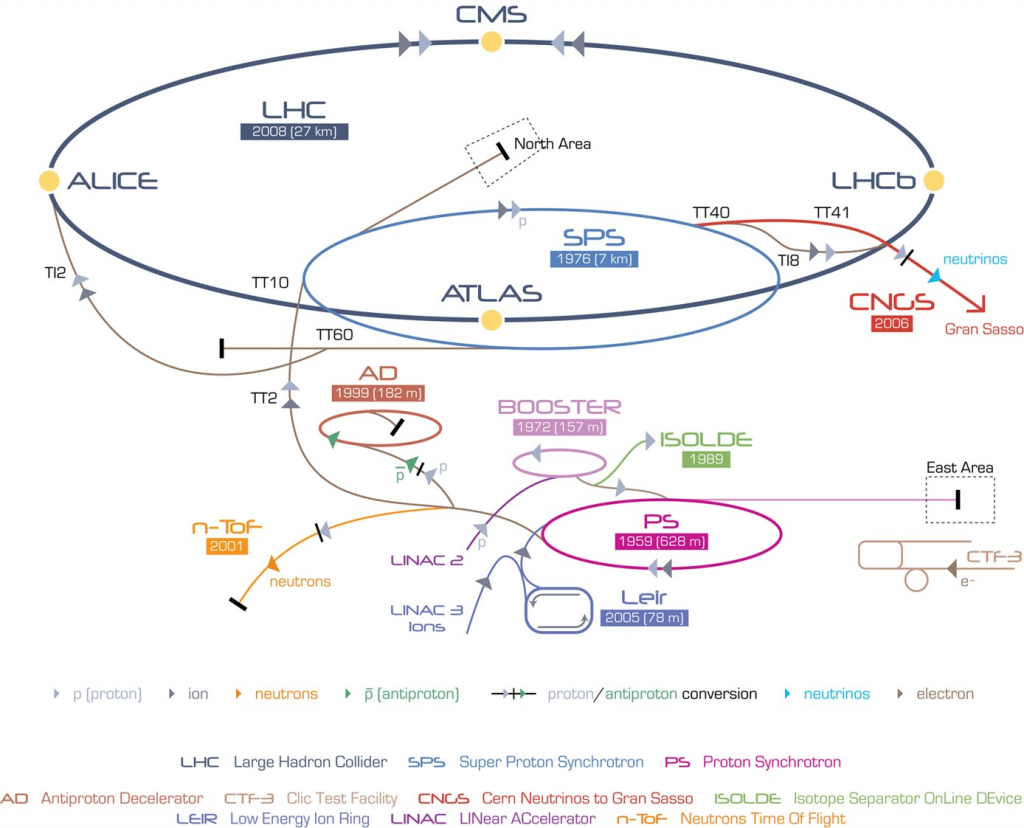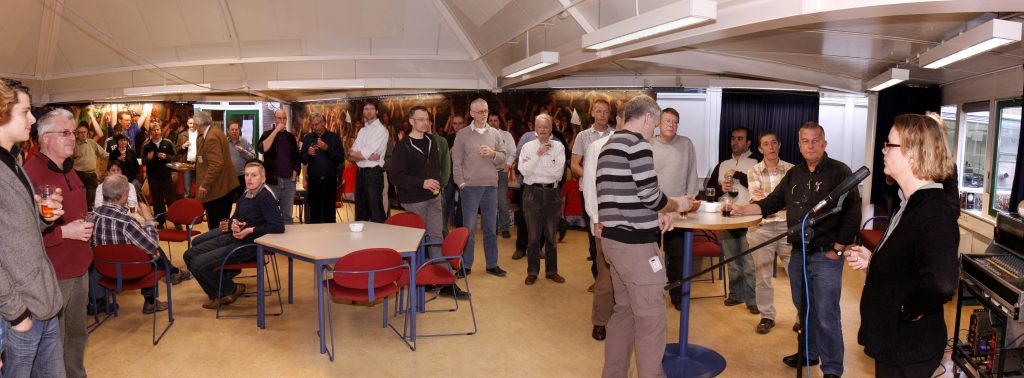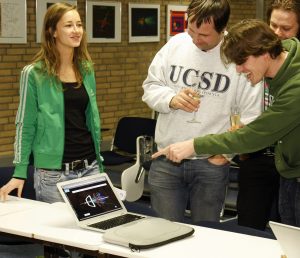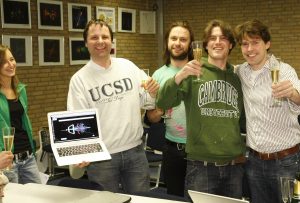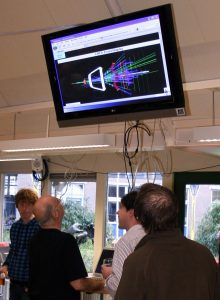The Large Hadron Collider went into operation at CERN, in Geneva, on 30 March 2010. Ten years on, the work of the world’s largest particle collider is still far from over.
A red cylinder of hydrogen gas on display at the CERN particle lab’s visitor centre near Geneva represents the modest source of the largest experiment in the world. In another part of CERN’s Meyrin site, molecules of this simplest chemical element are stripped of their electrons. Protons, the hydrogen nuclei, then begin a long journey through ever larger pre-accelerators (injection accelerators) and storage rings.
Inside the accelerator complex, magnets and electric fields drive the protons – step by step – to ever higher speeds, until they have almost reached the speed of light.
Only then, do they enter the LHC. The protons’ run-up ends in the 27-kilometre LHC ring that straddles the border between France and Switzerland up to 100 metres underground. Here, as they zip round in two opposite directions, these protons have an unparalleled beam energy of 7 TeV, far exceeding that of any other accelerator in the world.
‘Beam’ is not the right word, actually. Travelling in two directions, discrete bunches of protons zip along the beam pipe at almost the speed of light, guided and focused by more than a thousand cryogenically cooled superconducting magnets. The liquid helium refrigeration systems needed to cool these magnets are the largest of their kind in the world.
The view inside the tunnel is overwhelming to visitors. A seemingly endless array of five- to fifteen-metre long blue and red magnets stretches away into the distance. In both directions, the distant curve of the 27-kilometre underground structure is so slight that the tunnel looks as straight as an arrow.
Gigantic microscope
These bunches of protons are made to collide at four points around the accelerator ring, causing some protons to hit each other head-on. At these interaction points, gigantic detectors record the debris and new particles that are released in these collisions. Physicists then attempt to understand those particle patterns. These experiments enable them to test existing theories about particles and fundamental forces. The physicists are also trying to uncover previously unknown processes and interactions, which may lead to a more profound understanding of reality.
Physicists often compare the LHC to a gigantic microscope for peering even more deeply into the clockworks of the universe. And it is precisely because the LHC has to examine such tiny objects that it needs to be so incredibly large and powerful.
Camera crews
The LHC accelerator began its normal working life in the early afternoon of 10 September 2008. This event attracted enormous interest from the media. After decades of calculations and design work, it had taken a further eight years to actually build the giant accelerator.
Surrounded by members of the press and camera crews, hundreds of officials, physicists and technicians were gathered in the control rooms that day. They could actually see the proton beam being generated and accelerated. After being injected into the LHC ring, the beam hit a target plate at the next station. A quarter, half, three quarters. And then all the way round.
As the very first protons zipped through the accelerator, people cheered, hugged, and patted colleagues’ shoulders. Bottles of champagne were uncorked. The man who built the accelerator, Lyn Evans, was sitting in the front row of seats in the control room. A legend among his peers, Evans raised his glass extra high, in sheer relief.
This was the start of a new era. Well, in the accelerator physics business, at least. It was the first time that superconducting magnets had been used on this scale. These magnets had been specially developed for the new European particle collider. They enable the LHC to accelerate protons, particles much heavier than electrons, around the 27-kilometre tunnel that previously housed the old Large Electron-Positron (LEP) collider.
New energy domain
In particular, the hope was that this would usher in an entirely new era of particle physics. Physicists had been eagerly awaiting the opportunity to make measurements in a new energy domain. In its day, the LEP accelerator – which had previously occupied the same 27-kilometre tunnel under the Franco-Swiss border – was the largest accelerator ring in the world. Until the year 2000, this machine had been involved in the search for the famous Higgs particle, the missing piece in the Standard model. Many people had also hoped to find indications of supersymmetry – signs of a completely new, previously unknown world of particles.
So, there were very good reasons for the LHC to open up a new energy domain. The old LEP was able to accelerate electrons and their antiparticles into frontal collisions involving a beam energy of 210 GeV (0.42 TeV collisions). The Large Hadron Collider proton accelerator can achieve collisions up to 14 TeV (on paper at least), which is nearly 35 times as much collision energy.
LEP tunnel stripped bare
Eight years had passed since the closure of LEP on 2 November 2000. Some physicists had objected to this, believing that the old accelerator had actually come very close to detecting the Higgs particle. The LEP tunnel was stripped bare and new equipment was installed in the empty tunnel, together with the new accelerator and four massive new underground particle detectors – ATLAS, CMS, LHCb and ALICE.
During all those years without a meaningful beam, there had been nothing to measure and no chance whatsoever of making new discoveries. Throughout this period, European scientists watched nervously as labs with smaller machines, such as Fermilab in the US, continued their own search for the Higgs particle or supersymmetry.
After years of intensive development, design, construction, and testing, the LHC began operations on 10 September 2008. It was at least a year behind schedule, nevertheless there was an enormous sense of relief. Finally, the physicists had a beam again. The hunt for new physics could continue, now with the largest accelerator that had ever been built.
Badly welded contact
Only nine days after the first beam fired up, fate threw a curve ball. On the night of September 19, the current flowing through a poorly welded contact in one of the ring’s superconducting magnets heated up the passing liquid helium. The resulting explosion shut down the accelerator, and partially disrupted operations.
After the disaster, all contacts, adjustments and repairs were minutely examined. It took until 2010 before all this work was completed and the accelerator could be fired up once again. Its routine use as a working particle collider began on 30 March 2010. The protocol agreed prior to this restart was that the beam energy should be increased incrementally, rather than trying to operate the accelerator at full blast straight away. Meanwhile, the physicists were finally able to make real measurements.
The first runs of LHC protons did not exceed a collision energy of 0.450 TeV, about the same energy as the LEP achieved with electrons. In fact, it fell far short of this energy level when it came to meaningful collisions. This is because protons are composite particles, whose three quarks carry only part of the total collision energy.
The silver lining was that all of the detector experiments in the LHC ring (Nikhef – the Dutch National Institute for Subatomic Physics – is involved in ATLAS, LHCb and ALICE) were now fully up to scratch. Two years previously, they would have struggled to operate effectively.
By November 2009, the beam energy had been stepped up from a cautious 0.450 TeV to 1180 GeV (1.18 TeV). That was especially satisfying, as it was significantly more than the Tevatron accelerator in the US – a potential competitor in the hunt for the Higgs particle – could deliver (just under 1 TeV). For the first time, the LHC was really opening up a new energy field. In March 2010, when the accelerator restarted, it was able to deliver an energy of 3.5 TeV.
Nervous restart
Everyone involved remembers the day of the restart as a particularly nervous time. As the world’s press looked on once more, two attempts to send a beam round the ring failed. Another day passed before the scientists succeeded in getting bunches of protons (2244 in the entire ring) to collide in both the ATLAS and CMS detectors, the two immense flagships of the new LHC physics. Throughout 2011 and into 2012 (the LHC’s Run 1), the beam energy remained at just 3.5 TeV, half of the LHC’s design capacity. In 2012, the beam energy was cautiously cranked up to 4 TeV for the first time, thus achieving collisions of up to 8 TeV.
The Higgs particle
By that time, the accelerator – operating at a relatively low collision energy – had produced only a tiny fraction of the particle collisions that the LHC’s service-life folder had promised. However, that turned out to be enough. In what was the absolute zenith of particle physics in the brand-new 21st century, LHC scientists discovered the long-predicted Higgs particle.
On 4 July 2012, ATLAS and CMS jointly presented ample evidence for the existence of a particle with a mass of 125 GeV that, in theory, dictates the mass of all other elementary particles. The discovery made front-page headlines around the world. A year later, in 2013, the theoretical physicists Peter Higgs and Francois Englert received a Nobel Prize for predicting the existence of this particle (see TEN YEARS OF LHC PHYSICS). In that same year, the ATLAS and CMS detectors shared the European Physical Society (EPS) prize for the actual discovery in the real universe.
During Long Shutdown 1, the LHC accelerator’s first scheduled maintenance shutdown (from 2012 to 2014), the collider’s equipment systems were further adapted and improved. During Run 2, which commenced in 2015, the LHC achieved beam energies of 6.5 TeV. The accelerator engineers’ growing mastery over their machine meant that the beam was available more often. They were also able to crank up its intensity, by increasing the number of protons per bunch, and by reducing the distance between bunches as they zipped round the ring.
Five percent of data
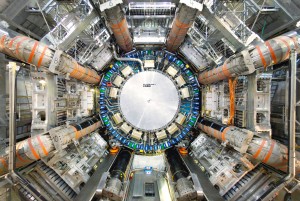
During Run 2, until the start of the second (and current) maintenance shutdown – Long Shutdown 2 (from 2018 to 2021) – the LHC produced proton beams with an energy of 6.5 TeV, thus achieving frontal collisions of 13 TeV. There are about one billion proton-proton collisions in the detectors every second. In total, the LHC has now produced about five percent of all the collisions it will create in its entire service life: 150 inverse femtobarns or fb-¹ (a measure of the number of collisions) of the predicted 3000 fb-¹. According to its schedule, the LHC has about twenty years to go.
For a substantial part of this time, the beam will not be restricted to delivering the full 14 TeV of collision energy. A range of new techniques will be used to create a beam that is up to ten times more intense than before. CERN is currently in Long Shutdown 2. Meanwhile, preparations for this High-Luminosity Large Hadron Collider (HL-LHC) are in full swing. Some of the detectors and computer facilities are already being prepared for the future tsunami of measurement data. Nikhef plays a substantial role in this too.
The LHC is scheduled to awaken from its second major shutdown sometime before the summer of 2021. The experiments will have an extra year of measuring time. During Run 3 they will probably collect twice as much measurement data as before. With all that extra data to boost statistical accuracy still further, the teams hope to detect new phenomena and particles.
Photos of the 30th of March 2010 at Nikhef in Amsterdam:
TEN YEARS OF LHC PHYSICS: Higgs and much more
On the afternoon of 4 July 2012, the spokespersons for the ATLAS experiment (Fabiola Gianotti, who went on to became CERN’s Director-General) and the CMS detector jointly announced the discovery of the final missing piece in particle theory – the Higgs boson. At CERN and scientific institutes throughout the world, rooms resounded with cheers and thunderous applause. An elderly Peter Higgs wiped away a tear in the auditorium in Geneva.
The particle that bears his name is part of a universal field that, according to the theory that he and others formulated in the 1970s, dictates the specific mass of all elementary particles. It supplements the Standard Model, which describes the range of building blocks that make up the universe, and the forces that govern them.
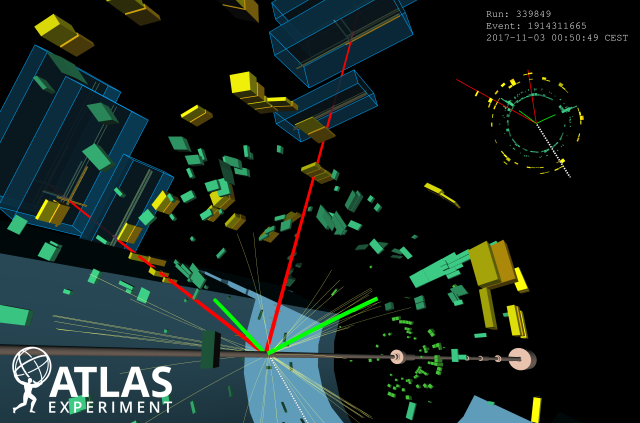
After eighteen months of measurements, using entirely different approaches, both experiments found a significant peak in their data at an energy of 125 GeV. This was evidence for the existence of a particle with that mass, which decayed into a pair of photons, for example. This breakthrough was world news. Since then, the discovery of the Higgs particle has been seen as the LHC project’s crowning glory.
However, this glorious success has somewhat overshadowed many other physics experiments in the LHC’s programme, particularly in the public domain. To begin with, the discovery of this 125 GeV particle has raised more scientific questions than it has answered. Most physicists are convinced that this Higgs particle is indeed the one predicted by theory. However, a lot more research is needed to find out if it is the only one, or merely the simplest one.
Only now, five years on, are measurements starting to appear that really address this particle’s relationship to other particles in the Standard Model. These hold the promise of new tests for the Standard Model and, perhaps, significant deviations from that model as well. The discovery of the Higgs particle in 2012 was a triumph, one that marked the end of a very long quest. At the same time, it represented the beginning of a new era in physics.
So far, the vast majority of results from LHC experiments have confirmed the predictions of the Standard model. Those who had hoped to easily find previously unknown particles, such as the building blocks of dark matter or supersymmetry, have been disappointed. At the same time, however, work at the LHC also serves as an acid test for theoretical predictions that attempt to look beyond the Standard model (BSM).
And many important questions about the Standard Model itself still remain unanswered. The Higgs field and its particles are actually a fairly arbitrary addition to the theory, which does work – even though we don’t know exactly how.
In a detailed CERN Courier review article covering ten years of LHC physics, senior CERN theoretical physicist Michelangelo Mangano recently speculated on the origins of the specific Higgs boson that was detected in the LHC. It is even conceivable that the Higgs boson in question is not an elementary particle at all, but is instead made up of even more fundamental elements. Further measurements and smarter analyses are the only way to clarify the matter.
The LHCb detector in particular focuses on strange phenomena in the world of quarks – the building blocks of nuclear particles and other matter. Over the course of ten years, the LHC has spotlighted mysterious differences between matter and antimatter with far greater precision than ever before. Properties of rare quarks have been measured with a degree of precision that theorists struggle to achieve using the Standard Model.
According to Dr Mangano, the LHC could still fill in a lot of blanks in the area of supersymmetry as well. We should have found evidence for the simplest version of this principle long ago. However, more baroque forms of supersymmetry cannot be excluded, writes the CERN theorist, adding that the experimentalists and the theorists are now cooperating more closely than ever.
Critics sometimes like to point out that the LHC has simply confirmed a prediction that was made half a century ago. They complain that it has not led to the discovery of any new physics, such as supersymmetry or dark matter. However, as the accelerator has only completed a fraction of its projected measurements, that would seem to be a rather premature conclusion. Perhaps the evidence for new physics is so subtle that a huge number of measurements will be needed to bring it to light. The LHC is going to be in the collision business for a long time yet.

Jos Engelen, now Emeritus Professor of Particle Physics at the University of Amsterdam, formerly Director of Nikhef (2001 to 2003), and Chief Scientific Officer at CERN (2008): ‘We were all overjoyed when the LHC accelerator started up on 10 September 2008. Everyone had worked so hard, and it worked like a charm. That day, our eyes were glued to the monitors as the beam circled the 27-kilometre ring, step by step. We were surrounded by hundreds of journalists, partly because some people were worried that we might create a black hole that would swallow everything. Nothing of the kind happened, of course. Then came that fateful explosion one week later, caused by an overheated superconducting contact – one bad weld among thousands in the gigantic machine. It came as a great relief when the accelerator restarted in March 2010. Since then, the LHC has been the pride of European particle physics – culminating with the discovery of the Higgs in 2012. The LHC has turned CERN into a global brand, I am convinced of that.’
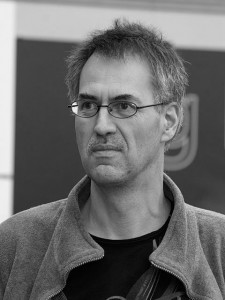
Frank Linde, now Leader of the Gravitational Waves Programme at Nikhef, formerly one of the builders of CERN’s huge ATLAS detector (2010) and Director of Nikhef (2005 to 2014): ‘At CERN, we fired up the LEP accelerator in 1989 and ran it until the year 2000. Yet as long ago as 1992, I can recall fierce discussions about a new super accelerator for protons. I wasn’t entirely convinced. It’s difficult to make sense of the mess created when you smash quark trio’s like protons into one another. But the pressure was on, Nikhef had to choose a major experiment and get on board. The matter was decided in a shoot-out between the various ideas in a meeting room at Amsterdam Airport Schiphol. Nikhef chose ATLAS, which by the way had started life as EAGLE. That this led to the discovery of the Higgs in 2012 was, of course, fantastic. It was a dream come true. That said, I’m still upset that CERN was not awarded a Nobel Prize for this achievement. Personally, that’s something I was quite disappointed about.’

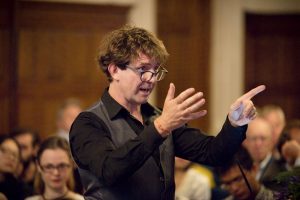
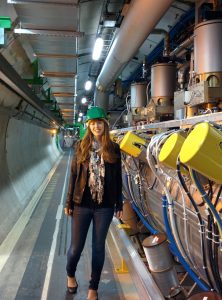
Clara Nellist, now Nikhef physicist Radboud University Nijmegen, then (2010) PhD student in the ATLAS experiment at CERN: ‘It sounds a bit strange, but I have only seen the LHC accelerator once in real life. That was during an open day in 2014, as a visitor. It was surreal, because I had already seen so many pictures of it and read a lot about it. But to see the huge blue pipe with all those magnets really disappear into the distance is quite surreal. I’m a runner. My secret dream since then has been to run the whole 27 kilometers around the tunnel.
When the LHC is on, you can’t access it, and if you work on the detector underground, you’ll only see the end of the beam pipe. The accelerator delivers us the proton collisions we want to study. But it’s not like you’re just getting water out of the tap, it’s a real close collaboration between the experiments and the accelerator physicists and engineers. We challenge each other all the time. We want to measure as much as possible, they want a machine that runs perfectly. That brings out the best in both. From the start in 2010 I don’t remember that much, we were busy every day and this was just another step, plus they didn’t have a live stream at my University at the time. I do know though that many PhD students were relieved that we could finally do physics measurements. Everyone couldn’t wait to get their hands on the data.’
